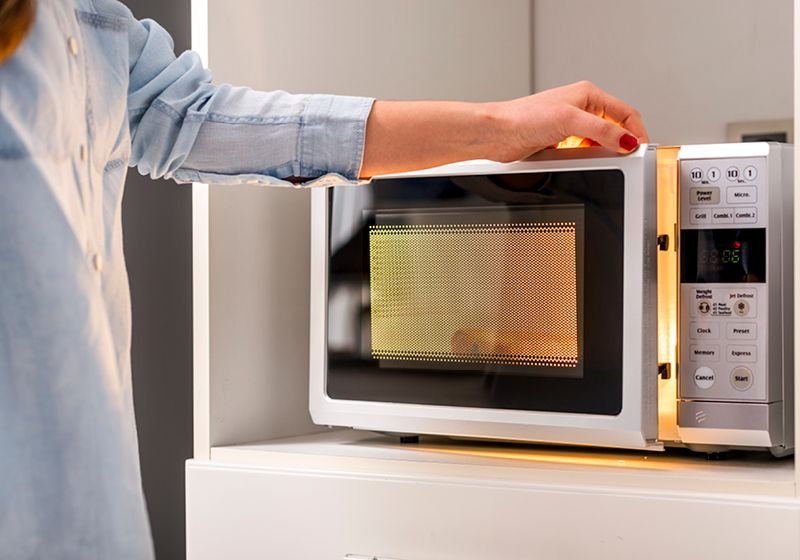From hot springs to rocks deep beneath the ocean floor, bacteria thrive in the unlikeliest of places. Now, Manuel Porcar, a microbiologist at the University of Valencia and the chief executive officer of Darwin, a company that works on industrial applications of microbes, found another bacterial abode: the microwave.1 In their paper published in Frontiers in Microbiology, the team reported the discovery of, for the first time, microbial communities living inside microwaves. These findings offer microbiologists a new avenue to study hardy microbes for potential biotechnology applications.
Porcar and his team at Darwin explore different environments in the search of new microbes, especially ones that could have industry applications. While the team generally investigated fermented foods, stool samples, and soil, they were keen to explore non-traditional environments, such as the microwave. “They can still have some interesting microbial diversity,” said Porcar.
Alba Iglesias, a postdoctoral researcher in Porcar’s lab and coauthor of the study, swabbed samples from microwaves from homes, shared spaces, laboratories, and industrial settings. Upon sequencing the swabs and culturing the bacteria in Petri dishes, the team identified various species.
Home microwaves harbored a lot of bacteria that are found on the human skin and other kitchen surfaces that humans frequently contact, with some examples being Bacillus, Micrococcus, and Staphylococcus. The scientists also found some pathogenic bacteria like Enterobacter, Klebsiella, and Pseudomonas.
Pankaj Mehta, a biophysicist at Boston University studying microbial ecosystems, cautioned that the study is still preliminary and that there are technical reasons to not be too worried about pathogens in the microwave. This is because given how bacteria are sequenced, which is using information in their 16S ribosomal RNA, one can only roughly assign the bacteria to a genus based on databases.
“While there are pathogenic strains in these genuses, you really have to sequence the whole bacteria to know anything about pathogenesis,” said Mehta. He added that even with the whole sequence it’s not always easy to tell pathogenicity, as the bacteria can still function differently. “You can have even two strains of the same species, and one strain can be pathogenic, and the other strain can’t. It’s almost impossible to know whether something is pathogenic or not,” he added.
While the lab microwaves also housed some skin bacteria, they were home to extremophiles that are known to withstand high temperatures and harsh doses of radiation, like the ones found in deserts or on solar panels. For instance, the team found Deinococcus, one of the strongest bacteria alive with the ability to survive in outer space as well, and Chloroflexi has been found in Yellowstone hot springs. 2,3
“Our hypothesis is that they are adapted to such conditions, because if you imagine a solar panel, it’s a flat glass surface without any water retention ability that is heated a lot during the day. There’s a lot of radiation and oxidative stress,” said Porcar. “And the microorganisms that are able to withstand such conditions very likely are able to withstand relatively similar conditions like inside the [lab] microwave oven.”
According to Jason Tetro, a freelance microbiologist from Edmonton, Canada, who is also known as “The Germ Guy,” the microbes in the home microwaves may not be going through the same level of radiation as the ones in the labs. “If you have any kind of burst as a result of heat, [the food] is going to end up on the surfaces, right? But the microbe itself is not going to end up on the surface, it’s going to be a biofilm with organic matter that’s on the surface,” explained Tetro. “These microbes themselves are not going to be resistant to the microwave energy. Instead, they are in organic matrices that are protecting them.”
“I’ve constantly for 15–20 years been saying ‘clean the outside of your microwave, make sure it’s disinfected. You do not want the outside of your microwave to be a vector.’ Now it looks like we’re going to include the inside of the microwave as well,” said Tetro.
Mehta believes that this is yet another example of how microbial communities can survive in extreme environments—from space shuttles to nuclear reactors, and now microwaves. “It might be interesting to understand if it’s because they live in these dead spots where there’s less heating or they really have adapted in some way,” he added.
The study opens many avenues to explore how bacteria seem to be constantly adjusting to new environments, according to Mehta. “You are living in this high radiation environment; how is the DNA changing? I think there’s a lot of interesting scientific questions about microbes and extreme environments, and the mechanisms of how they seem to grow everywhere.”

